
Written by Chris Burnham and Dennis Culver
Drawn by Ramon Villalobos
Colored by Ian Herring
Published by Marvel Comics
Just imagine how great (and it is pretty darn spiffy as it is) Grant Morrison’s New X-Men run could have been if when Frank Quitely couldn’t have drawn the book, Ramon Villalobos would have been around to fill in. E Is For Extinction #2 makes the argument that Villalobos would have been the equal, if not superior, artist. Chris Burnham, Dennis Culver, and Villalobos take a Secret Wars tie-in, even if the Secret Wars aspect is just a thin tangent, and spin a What If? tale that doesn’t need its tie-in raison d’etre. What If Magneto Won is all it needs. What if Cyclops, Emma and Wolverine were losers in personality as well as in the mutant race? That last one may be a bit unwieldy as a What If? title, but c’mon, that’s what Morrison was really trying to get at in all of his stories.
It’s almost odd to see this era of the X-Men revisited as a piece of nostalgia, but Morrison’s run started in 2001 and so much has happened since then even if his run feels just as lively today as it did back in the early aughts. But this What If? story picks up Morrison’s theme of the old versus the new. It’s the X-Men you know and love against the new mutants, the young upstarts who should be finding their places in your hearts. Only these new New X-Men, the students and headstrong prodigies of the past, don’t have the moral fortitude that we think their elders have. Of course Cyclops and Wolverine are only in this battle because Magneto has Jean Grey trapped in an egg in the basement of The Atom Institute, the equivalent of Xavier’s School For Gifted Youngsters in this mish-mashed Secret Wars reality.
E Is For Extinction #2 is all about conflict and battle. It’s quite literally a battle of generations, of the kids rebelling against their parents and teachers. But rebelling against what doesn’t seem like something any of the creators have any interest in exploring this issue. Essentially it boils down to the flimsy idea that Magneto is bad and that he has to be stopped but hasn’t that been the premise of every X-Men story since 1963, including Morrison’s? Even if the battlelines break down along generational fronts, there’s little reasoning to this antagonism other than a bit of old-fashioned cattiness. “We’re your worst nightmare, Ms. Frost. Five reminders of your former glory,” the psychic Cuckoo sisters taunt. Or worse yet, it comes down to bragging about the younger generation’s sexual prowess. “Although you should probably know, she thinks you lack my youthful vigor, old man,” mutant bad boy Quentin Quire declares to Magneto and we all know what he’s talking about. Wink, wink.
Burnham and Culver get so wrapped up in the What If?iness of everything that they fall prey to the weak links of these stories. What If? stories almost always assumed that you’re already so invested in the story that you don’t need things like conflict or narrative progression. And it’s almost deceptively hard to notice that there are no stakes to this battle because Villalobos sells all of the action like this was the massive conclusion to a multiyear storyline. It’s almost easy to believe that this is the big blowout New X-Men conclusion that Frank Quitely never got to draw.
E Is For Extinction #2, without any real revelatory character work or struggles, ends up being one giant fight comic. Villalobos and colorist Ian Herring choreograph a brutal fight, no matter whether the fight is verbal or physical. The pettiness of both the good and bad guys makes this comic just a fight about egos which seems exciting but ends up being a bit empty because for all of the bluster, it’s not really fighting for anything other than being just another tie-in to an event that has a massive amount of tie-ins.



